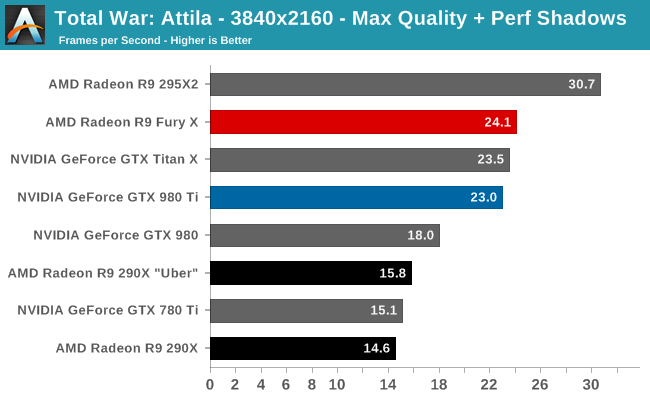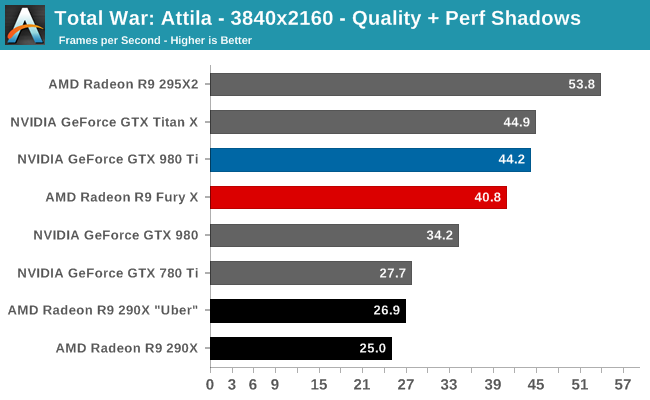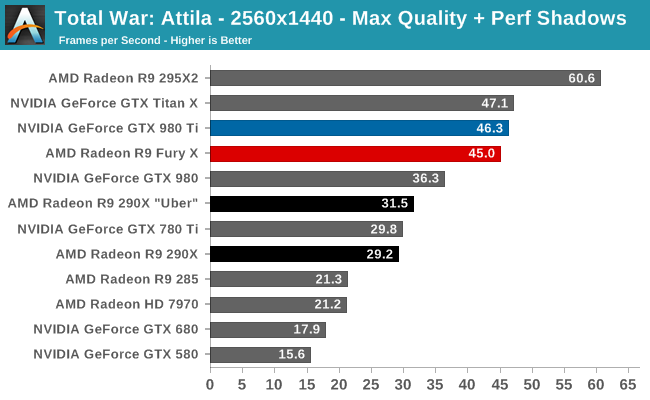The AMD Radeon R9 Fury X Review: Aiming For the Top
by Ryan Smith on July 2, 2015 11:15 AM ESTTotal War: Attila
The second strategy game in our benchmark suite, Total War: Attila is the latest game in the Total War franchise. Total War games have traditionally been a mix of CPU and GPU bottlenecks, so it takes a good system on both ends of the equation to do well here. In this case the game comes with a built-in benchmark that plays out over a large area with a fortress in the middle, making it a good GPU stress test.



Attila is the third win in a row for AMD at 4K. Here the R9 Fury X beats the GTX 980 Ti by 5% at the Max quality setting. However as this benchmark is very forward looking (read: ridiculously GPU intensive), the actual performance at 4K Max isn’t very good. No single GPU card can average 30fps here, and framerates will easily dip below 20fps. Since this is a strategy game we don’t have the same high bar for performance requirements, but sub-30fps still won’t cut it.
In which case we have to either compromise on quality or resolution, and in either case AMD’s lead dissolves. At 4K Quality and 1440p Max, the R9 Fury X trails the GTX 980 Ti by 8% and 3% respectively. And actually the 1440p results are still a good showing, but given AMD’s push for 4K, to lose to the GTX 980 Ti by more at the resolution they favor is a bit embarrassing.
Meanwhile, Atilla has always seemed to love pushing shaders more than anything else, so it comes as no great surprise that this game is a strong showing for the R9 Fury X relative to its predecessor. The performance gains at 4K are a consistent 52%, right at the top-end of our performance expectation window, and a bit smaller (but still impressive) 43% at 1440p.










458 Comments
View All Comments
TallestJon96 - Sunday, July 5, 2015 - link
This card and the 980 ti meet two interesting milestones in my mind. First, this is the first time 1080p isn't even considered. Pretty cool to be at the point where 1080p is considered at bit of a low resolution for high end cards.Second, it's the point where we have single cards can play games at 4k, with higher graphical settings, and have better performance than a ps4. So at this point, if a ps4 is playable, than 4k gaming is playable.
It's great to see higher and higher resolutions.
XtAzY - Sunday, July 5, 2015 - link
Geez these benchies are making my 580 looking ancient.MacGyver85 - Sunday, July 5, 2015 - link
Idle power does not start things off especially well for the R9 Fury X, though it’s not too poor either. The 82W at the wall is a distinct increase over NVIDIA’s latest cards, and even the R9 290X. On the other hand the R9 Fury X has to run a CLLC rather than simple fans. Further complicating factors is the fact that the card idles at 300MHz for the core, but the memory doesn’t idle at all. HBM is meant to have rather low power consumption under load versus GDDR5, but one wonders just how that compares at idle.I'd like to see you guys post power consumption numbers with power to the pump cut at idle, to answer the questions you pose. I'm pretty sure the card is competitive without the pump running (but still with the fan to have an equal comparison). If not it will give us more of an insight in what improvements AMD can give to HBM in the future with regards to power consumption. But I'd be very suprised if they haven't dealt with that during the design phase. After all, power consumption is THE defining limit for graphics performance.
Oxford Guy - Sunday, July 5, 2015 - link
Idle power consumption isn't the defining limit. The article already said that the cooler keeps the temperature low while also keeping noise levels in check. The result of keeping the temperature low is that AMD can more aggressively tune for performance per watt.Oxford Guy - Sunday, July 5, 2015 - link
This is a gaming card, not a card for casuals who spend most of their time with the GPU idling.Oxford Guy - Sunday, July 5, 2015 - link
The other point which wasn't really made in the article is that the idle noise is higher but consider how many GPUs exhaust their heat into the case. That means higher case fan noise which could cancel out the idle noise difference. This card's radiator can be set to exhaust directly out of the case.mdriftmeyer - Sunday, July 5, 2015 - link
It's an engineering card as much as it is for gaming. It's a great solid modeling card with OpenCL. The way AMD is building its driver foundation will pay off big in the next quarter.Nagorak - Monday, July 6, 2015 - link
I don't know that I agree about that. Even people who game a lot probably use their computer for other things and it sucks to be using more watts while idle. That being said, the increase is not a whole lot.Oxford Guy - Thursday, July 9, 2015 - link
Gaming is a luxury activity. People who are really concerned about power usage would, at the very least, stick with a low-wattage GPU like a 750 Ti or something and turn down the quality settings. Or, if you really want to be green, don't do 3D gaming at all.MacGyver85 - Wednesday, July 15, 2015 - link
That's not really true. I don't mind my gfx card pulling a lot of power while I'm gaming. But I want it to sip power when it's doing nothing. And since any card spends most of its time idling, idling is actually very important (if not most important) in overal (yearly) power consumption.Btw I never said that idle power consumption is the defining limit, I said power consumption is the defining limit. It's a give that any Watt you save while idling is generally a Watt of extra headroom when running at full power. The lower the baseline load the more room for actual, functional (graphics) power consumption. And as it turns out I was right in my assumption that the actual graphics card minus the cooler pump idle power consumption is competitive with nVidia's.